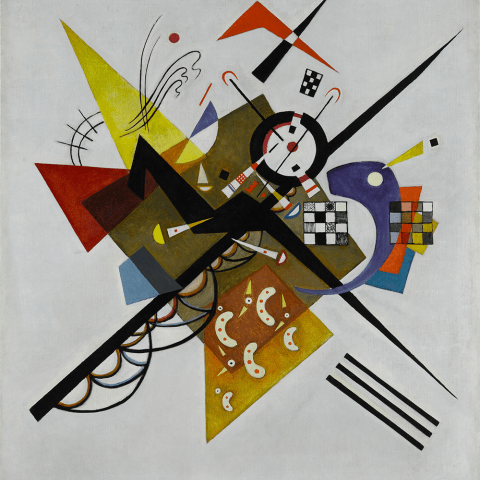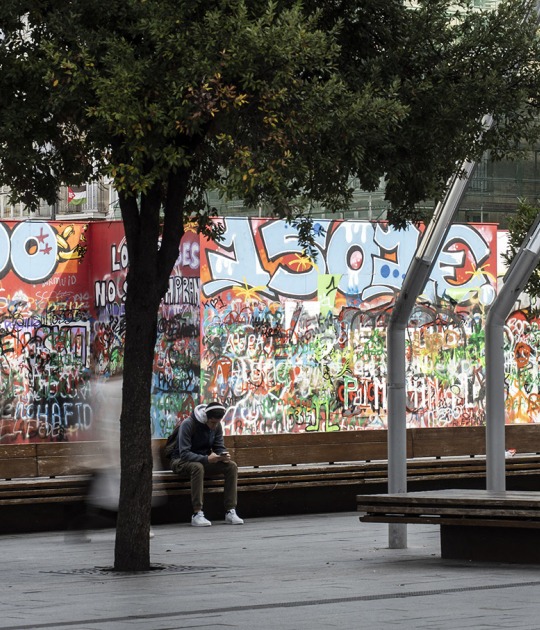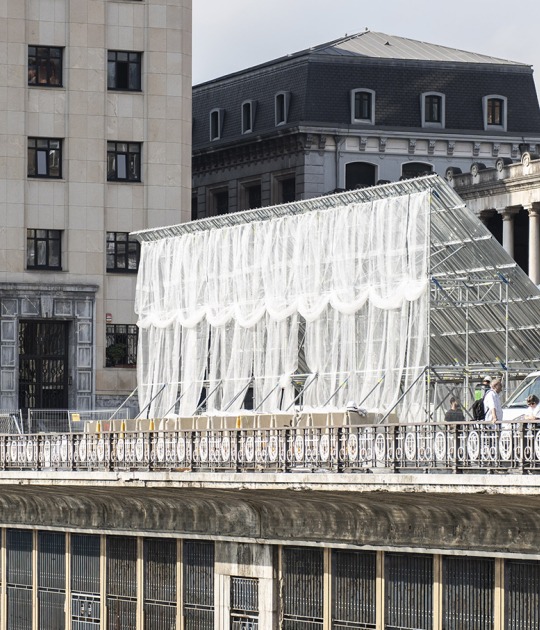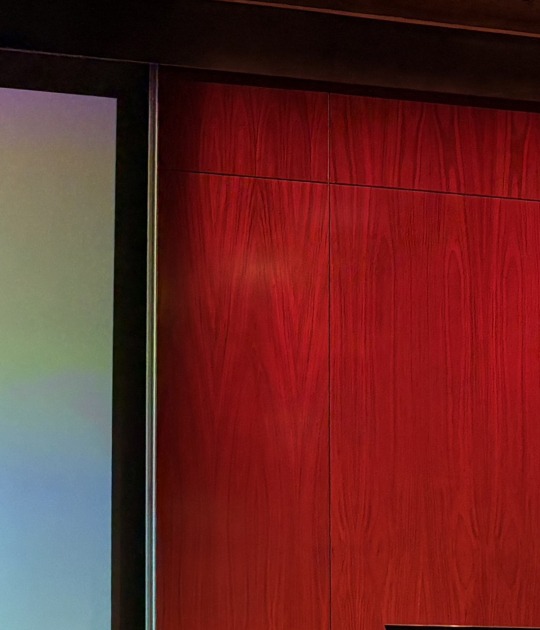The exhibition was exposed in 2014 at the Palazzo Reale in Milan, before traveling to Milwaukee and Nashville, United States. In Madrid it will be seen in CentroCentro until February 28, 2016.
Completed almost 150 years since the birth of Wassily Kandinsky (1866-1944), pioneer of abstract art and one of the leading avant-garde painters, this retrospective covers his artistic and spiritual path through about 100 masterpieces - paintings, watercolors and prints - from the collection of the Pompidou Centre. The exhibition is one of the largest monographs that have been made in Spain of the work of Russian painter so far.
A journey through the life and work of Kandinsky
The exhibition unfolds chronologically through eight rooms. The tour raised in four sections: Munich, 1896-1914, Russia, from 1914 to 1921, Bauhaus, 1921-1933, Paris, 1933-1944. Walk the key periods of Kandinsky's life, from early years in Germany, through his years in Russia and ending with his stay in France, through fundamental works as Alte Stadt II (1902), Lied (1906), Improvisation III (1909), Im Grau (1919), Gelb-Rot-Blau (1925) and Bleu de ciel (1940).
The Bauhaus, 1921-1933. In 1921, Kandinsky was director of the physical-psychological department of the Russian Academy of Artistic Sciences, a structure set up after the revolution. With the artistic climate deteriorating, an official mission to Germany offered him the opportunity to flee his country. A teaching position at the Bauhaus enabled him to pursue his work, even though his position as an abstract painter, in a school that was moving closer and closer to industry, was contested. On his arrival in 1922, he was asked by Walter Gropius to design a project for the entrance hall of a contemporary art museum which would be presented at the Juryfreie exhibition in Berlin.
A canvas from the Bauhaus period that the Kandinskys had hung in their dining room in Dessau, Auf Weiss II is the rework of a 1920 canvas and its theme of intercepting diagonals. However, it also recalls certain paintings of the 1910s that presented the confrontation of pictorial elements, a gigantomachy of lines and colours, like the events taking place on the canvas.
Development in brown is a sombre painting, completed in Berlin at the time of the closure of the Bauhaus. Deprived of its subsidies, the school was forced to close in the summer of 1933. This moment was rendered even more difficult for Kandinsky since the Nazis had demanded his departure from the school.
It is an exhibition organized by CentroCentro, the Centre Pompidou in Paris and the Arthemisia Group and is curated by Angela Lampe, Curator of Modern Art at the National Museum of Modern Art at the Pompidou Centre.
Dates.- from 20th October 2015 to 28th February 2016.
Venue.- Planta 1. Plaza de Cibeles, 1. Madrid-28014. Spain
Kandinsky Collection
The Musée national d’art moderne at the Centre Pompidou together with the Lenbachhaus Museum in Munich and the Solomon R. Guggenheim Museum in New York are the three international institutions holding the major part of Kandinsky’s works, with the exception of the pieces that remained in Russia when he left in 1921.
The Musée national d’art moderne bought only two works during the artist’s lifetime, in 1937 and 1939. However, in 1976 the museum received the donation of fifteen paintings and fifteen watercolours from Nina Kandinsky, then in 1980 the bequest: the contents of the artist’s studio in Neuilly, which gives the collection its specificity today. The collection has also been enriched with Kandinsky’s correspondence with personalities such as Christian Zervos, director of the Cahiers d’Art, Alexandre Kojève, philosopher and Kandinsky’s nephew, and the magistrate Pierre Bruguière who successfully handled his application for naturalisation, granted in 1939. However, the originality of the collection lies above all in the works on paper from the Moscow period. More recently, in 1994, the Kandinsky Collection of the Centre Pompidou has been the beneficiary of an acceptance in lieu agreement with the art dealer Karl Flinker and acquisitions carried out by the Kandinsky Society. In total, the collection contains more than 100 paintings, as many gouaches, over 500 drawings, sketchbooks, engravings and manuscripts.



![Auf Weiss II [On white II], 1923 Completed in Weimar, February-April 1923, Oil on canvas, 105 x 98 cm. Collection Centro Pompidou, Musée National d'Art Moderne, París. Legacy of Nina Kandinsky en 1976. © Vassily Kandinsky, VEGAP, Madrid, 2015 Auf Weiss II [On white II], 1923 Completed in Weimar, February-April 1923, Oil on canvas, 105 x 98 cm. Collection Centro Pompidou, Musée National d'Art Moderne, París. Legacy of Nina Kandinsky en 1976. © Vassily Kandinsky, VEGAP, Madrid, 2015](/sites/default/files/styles/mopis_news_carousel_item_desktop/public/metalocus_Kandinsky_mCC_07.png?itok=t6h1l8iV)







![Wassily Kandinsky Bleu de ciel (Sky Blue) [1], 1940 Oil on canvas, 100 x 73 cm. Legacy Nina Kandinsky, en 1976 N.° inv.: AM 1976-862. Fotografía © Centre Pompidou, MNAM-CCI / Servicio de documentación fotográfica de MNAM / Dist. RMN-GP © VEGAP, Madrid 2015. Wassily Kandinsky Bleu de ciel (Sky Blue) [1], 1940 Oil on canvas, 100 x 73 cm. Legacy Nina Kandinsky, en 1976 N.° inv.: AM 1976-862. Fotografía © Centre Pompidou, MNAM-CCI / Servicio de documentación fotográfica de MNAM / Dist. RMN-GP © VEGAP, Madrid 2015.](/sites/default/files/styles/mopis_news_carousel_item_desktop/public/metalocus_kandinsky_mcc_11.png?itok=_bp6Zv3I)


![Wassily Kandinsky Park von Saint-Cloud [1906] Oil on cardboard attached to cardboard 23,7 x 33 cm Legacy of Nina Kandinsky, 1981 N.° inv.: AM 81-65-30. Fotografía © Centre Pompidou, MNAM-CCI / Servicio de documentación fotográfica de MNAM / Dist. RMN-GP © VEGAP, Madrid 2015. Wassily Kandinsky Park von Saint-Cloud [1906] Oil on cardboard attached to cardboard 23,7 x 33 cm Legacy of Nina Kandinsky, 1981 N.° inv.: AM 81-65-30. Fotografía © Centre Pompidou, MNAM-CCI / Servicio de documentación fotográfica de MNAM / Dist. RMN-GP © VEGAP, Madrid 2015.](/sites/default/files/styles/mopis_news_carousel_item_desktop/public/metalocus_Kandinsky_mCC_13.png?itok=GDzX2L4A)
![Wassily Kandinsky Park von Saint-Cloud, Waldlichtung [1906 - 1907] Oil on cardboard 24 x 33 cm Legacy of Nina Kandinsky, 1981 N.° inv.: AM 81-65-29. Fotografía © Centre Pompidou, MNAM-CCI / Servicio de documentación fotográfica de MNAM / Dist. RMN-GP © VEGAP, Madrid 2015. Wassily Kandinsky Park von Saint-Cloud, Waldlichtung [1906 - 1907] Oil on cardboard 24 x 33 cm Legacy of Nina Kandinsky, 1981 N.° inv.: AM 81-65-29. Fotografía © Centre Pompidou, MNAM-CCI / Servicio de documentación fotográfica de MNAM / Dist. RMN-GP © VEGAP, Madrid 2015.](/sites/default/files/styles/mopis_news_carousel_item_desktop/public/metalocus_kandinsky_mcc_12.png?itok=-xEU5Pkd)




















